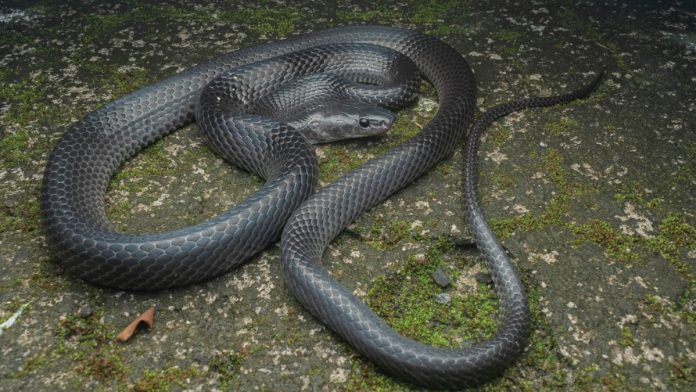New Delhi: A new species of wolf snake, harmless to humans, has been discovered in the dense forests of Great Nicobar Island by a team led by Pondicherry University’s researchers. The researchers have named this metre-long snake, with its glossy black skin, the Lycodon irwini, or Irwin’s wolf snake.
The naming was in honour of the popular conservationist and wildlife educationist Steve Irwin. Irwin, an Australian man who grew up around crocodiles and reptiles, shot to fame in the 1990s with the TV series, The Crocodile Hunter. He died in 2006 after an injury by a stingray on the set of a documentary.
The discovery was made in the largely unexplored forest by R.S. Naveen and S.R. Chandramouli from Pondicherry University, Zeeshan A. Mirza from Max Planck Institute for Biology, and Girish Choure from Pune.
A paper on Irwin’s wolf snake has been published in the journal Evolutionary Systematics.
“Studies suggested that the species is distinct, and a re-examination of museum material and newly collected specimens, combined with molecular analyses, confirms the distinctiveness of the species and is here described as a new species, Lycodon irwini,” the paper read.
Given its rarity and restricted range of travel within the Great Nicobar Island and considering potential threats, the researchers suggested that the new species could be classified as ‘endangered’ and included in the International Union for Conservation of Nature (IUCN) ‘Red List’.
Unique features
The 1.2-metre-long Lycodon Irwini is recognisable by its slim, elongated body and narrow tail. Its body has a smooth appearance, with a glossy black sheen on top and a shade of brown on its underside.
It is known to feed on reptiles, amphibians, and small mammals, living in the island’s thick evergreen forests.
“Currently, only four records of this species are known, three of which are based on collected specimens described in this study,” according to the study.
The researchers recorded the primary species or holotype of these snakes in the forest, in moist and humid conditions. This may be the reason why these snakes remained elusive and undetected for so long.
All known specimens from this species are from the Great Nicobar Island, according to researchers. Despite targeted surveys on other Nicobar Islands, it has not been recorded elsewhere. This suggests that the species’ presence is likely limited to the Great Nicobar, scientists said.
“Its rarity in field encounters implies it may be naturally scarce, highly cryptic, and possibly confined to the island’s evergreen forests,” the study added.
The discovery
The new species was identified when the researchers revisited a single specimen first documented in 2010. When they compared this with two newer records from the Great Nicobar Island, they found that each sample has unique traits, not seen in known wolf snakes. This made them realise that other families could also be living on the island.
Researchers emphasised the need for better research in these regions for a better understanding of the indigenous ecology and wildlife.
“Additionally, although the Nicobar Islands are bio-geographically linked to Sundaland, their isolated biota may represent distinct lineages, emphasising the need for focused taxonomy and conservation efforts,” the study read.
(Edited by Madhurita Goswami)
Also Read: Leopards & snakes in Gurugram, Ghaziabad? Two NCR wildlife superheroes on speed dial






